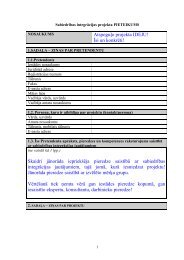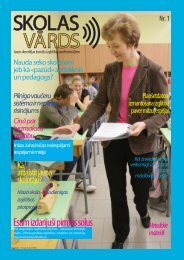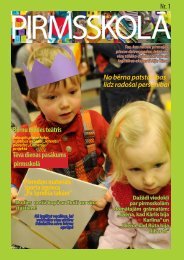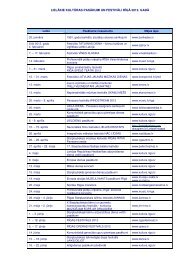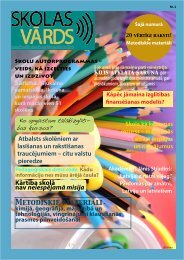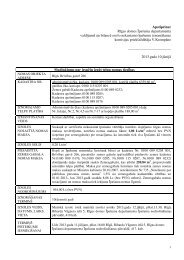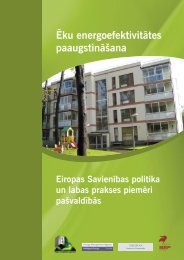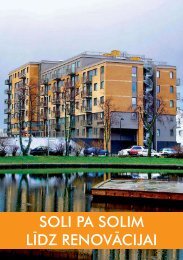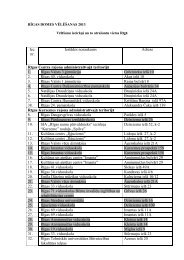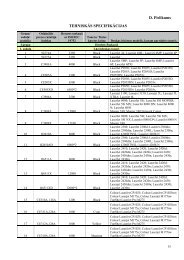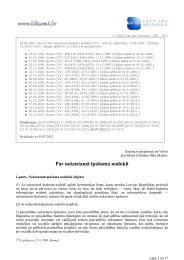Riga - European Capital of Culture 2014 candidate
Riga - European Capital of Culture 2014 candidate
Riga - European Capital of Culture 2014 candidate
- No tags were found...
You also want an ePaper? Increase the reach of your titles
YUMPU automatically turns print PDFs into web optimized ePapers that Google loves.
During the creation <strong>of</strong> <strong>Riga</strong>’s application, Latvia is celebratingthe 5 th anniversary since the largest expansion <strong>of</strong> the<strong>European</strong> Union to date. In <strong>2014</strong>, it will be a round anniversary– 10 years, which Latvia will celebrate with the <strong>European</strong><strong>Capital</strong> <strong>of</strong> <strong>Culture</strong> project. An additional benefit to the accentuation<strong>of</strong> the <strong>European</strong> perpendicular in public perceptionis Latvia’s anticipated presidency <strong>of</strong> the <strong>European</strong> Union in2015. <strong>Culture</strong>, in this context will have a doubly importantrole – as a messenger <strong>of</strong> public diplomacy, focusing attentionon the vector <strong>of</strong> the <strong>European</strong> unified values before thearrival <strong>of</strong> matters on the political agenda onto the stage, andoutlining the significance <strong>of</strong> each country, each person inthe development <strong>of</strong> the <strong>European</strong> dimension.It is currently estimated that in 2012 the single <strong>European</strong> currency,the Euro will be put into circulation in Latvia, with inhabitants makinga full transformation to a unified <strong>European</strong> currency for the settlement<strong>of</strong> their accounts. The introduction <strong>of</strong> the Euro into circulationwill be more than just a technical activity. It will be linked tothe way <strong>of</strong> thinking <strong>of</strong> people, with a more direct awareness <strong>of</strong> the<strong>European</strong> single market and a more direct practical and also mentalcontact with the <strong>European</strong> Union. This is another argument determinedby circumstances, which envisages an important role forculture, explaining the changes in the lives <strong>of</strong> each person associatedwith Europe, through the prism <strong>of</strong> cultural events. During thistime the eyes <strong>of</strong> the inhabitants <strong>of</strong> the entire country will be moreintensely turned towards <strong>Riga</strong>, where the major national institutionsare located, and therefore the preparation time for the <strong>Riga</strong>as <strong>European</strong> <strong>Capital</strong> <strong>of</strong> <strong>Culture</strong> project is a particular challenge,so that, using the potential <strong>of</strong> culture, a better understanding andsense <strong>of</strong> the advantages <strong>of</strong> a unified Europe can be achievedduring this psychologically sensitive time for society.This outlook <strong>of</strong> the near future not only makes us think about theopportunities <strong>of</strong> a unified market, but also remember the plusesand minuses that previous eras have meant to our ancestors regardingmarket relations with other <strong>European</strong> countries. One <strong>of</strong>the first Baltic ‘businesses’ or ‘gold currents’ that allowed for thedevelopment <strong>of</strong> culture and the achievement <strong>of</strong> a higher standard<strong>of</strong> living was trading with amber. And thus within the context <strong>of</strong><strong>2014</strong>, <strong>Riga</strong> will look to the ancient amber route, creating a newcooperation network and looking for today’s cultural ‘currency’within it. Thereby, in the historically tested paths <strong>of</strong> Europe we createimpulses for new cooperation content.In the context <strong>of</strong> a common Europe, however, the terms ‘old’ and‘new’ Europe implemented in his time by Donald Rumsfeld, theformer US Secretary <strong>of</strong> Defence, tend to dominate. Admittedly,since 2001 no new descriptions have arisen for the countries thathave now confirmed their status as full-fledged members <strong>of</strong> a unifiedEurope after 5 years within it. This division <strong>of</strong> ‘the new’ and‘the old’ Europe continues to live in the consciousness <strong>of</strong> peopleand continues the discussion in society about the divisional linesin Europe. <strong>Riga</strong> also perceives the search for new terms to describevarious groups <strong>of</strong> <strong>European</strong> countries as its task on its wayto the year <strong>of</strong> the <strong>European</strong> <strong>Capital</strong> <strong>of</strong> <strong>Culture</strong> project.One <strong>of</strong> the basic objectives <strong>of</strong> the <strong>European</strong> <strong>Capital</strong> <strong>of</strong> <strong>Culture</strong>project is the internal integration <strong>of</strong> Europe, exchange <strong>of</strong> experience,knowledge and different cultural experiences. It wouldappear that ‘good old’ Europe (that in politics is called ‘Europewhole and free’) has to incorporate an openness perspectivein relationships with the remaining cultural world. The <strong>European</strong><strong>Capital</strong> <strong>of</strong> <strong>Culture</strong> project allows us to realise how small Europeis, to what extent each nation within it is a relative and neighbourto the rest, and, on the other hand, confirms that by retaining ouroriginality, we can be interesting both to each other, and to othersin the world.Europe is united in its diversity. The countries forced to live behindthe ‘Iron Curtain’ were isolated. As we know, traditions anddifferences in languages and accents <strong>of</strong>ten survive in a certain,enclosed territory and also, for example, in Latvia, many traditionshave survived that are typical only to us or that have been typicalto many <strong>European</strong> nations, but that have now died out. It wouldappear that in this regard the isolationism defect can be transformedinto an effect, and traditions, different skills and knowledgecan be presented in a contemporary and surprising way,and as an opportunity for the <strong>European</strong> to experience somethingnew or long forgotten.The experience <strong>of</strong> renewed independence <strong>of</strong> almost 20 years allowsus to position ourselves as partners <strong>of</strong> equal value in Europe,who might not always have such long institutional experience invarious respects, but do, however, have ideas to <strong>of</strong>fer. This is confirmedby successful cooperation initiatives already begun.cooperation aspect in project implementationIn establishing cooperation on a <strong>European</strong> scale, <strong>Riga</strong> will <strong>of</strong>fer anew cooperation network initiative “New Amber Route”, developthe existing cultural cooperation networks, as well as creating newconnections through projects supported by <strong>European</strong> Funds.Thereby, the scope <strong>of</strong> <strong>Riga</strong>’s <strong>European</strong> dimension in terms <strong>of</strong> acooperation network is as follows:1 Cooperation network “New Amber Route” initiated by <strong>Riga</strong>;2 Participation in cooperation networks;3 Participation in <strong>European</strong> projects;4 The hosting <strong>of</strong> large <strong>European</strong> forums in <strong>Riga</strong>;5 <strong>Riga</strong>’s partnership towns;6 <strong>Culture</strong> in motion – artist mobility and cooperation betweencultural institutions.1 New amber routeWithin the framework <strong>of</strong> <strong>Riga</strong>’s candidacy we propose a newcooperation network initiative, with which to strengthen the understanding<strong>of</strong> Europe’s common values and <strong>Riga</strong>’s contributionto the communication <strong>of</strong> citizens across the borders. <strong>Riga</strong> andLatvia’s territory in general has for many centuries been a territorialpoint <strong>of</strong> intersection for the flow <strong>of</strong> people, ideologies, goodsand services not only, as is usually said, between the West and theEast, but also between Northern and Southern Europe. This is thehistorical Amber Route that has to become the new Amber route.Currently, the Northern dimension has been developed in the<strong>European</strong> Union, as well as cooperation between Baltic SeaStates, within the framework <strong>of</strong> the Council <strong>of</strong> the Baltic SeaStates, the first real drafts marked out for cooperation betweenthe Baltic States and Black Sea States within the framework<strong>of</strong> cross-border cooperation, and in the Southern part –Mediterranean cooperation networks. <strong>Culture</strong> has also beenallocated its niche within this cooperation network. However,the Task Group for <strong>Riga</strong>’s candidacy is convinced that the newAmber route cooperation developed within the context <strong>of</strong> the<strong>2014</strong> <strong>European</strong> <strong>Capital</strong> <strong>of</strong> <strong>Culture</strong> could serve as a wonderfulmeans <strong>of</strong> achieving new inspiration for the synergy <strong>of</strong> cultureand other sectors in the cooperation <strong>of</strong> Northern and Southern<strong>European</strong> countries and cities, transgressing the borders traditionallycalled Europe. In addition, as on the ancient route, so ourroute <strong>of</strong> today has two directions:• From the basin <strong>of</strong> the Latvian Baltic Sea through Lithuania,Poland, Germany, Austria, Italy, the Mediterranean basin;• From Latvia along the River Daugava, the Dnieper right up tothe basin <strong>of</strong> the Black Sea, Greece, Turkey and even further to theEast, to India.Our selection alone confirms that Europe has not only its historictrading routes but also routes entwined with secrets on the map,which today still captivate the minds <strong>of</strong> people and whose contemporarycontribution could be, as the economists would say,competitive on the circuit <strong>of</strong> global culture today.The “New Amber Route” does not envisage just an amber theme.Its main essence is to create a new contribution in the communication<strong>of</strong> people and culture within the specified geographicaxis, through the prism <strong>of</strong> culture activating cooperation projectsin entrepreneurship, environmental and climate-change issues,in science and medicine, and a citizens’ dimension. This cooperationnetwork could be called an expedition, which must revealthe secrets <strong>of</strong> today’s amber route. This expedition with new culturalcontacts has to create the cultural ‘currency’ <strong>of</strong> today – highquality cooperation projects, which are characterised by excellence,and the ability to captivate the minds <strong>of</strong> many people, improvingthe quality <strong>of</strong> life.2 Participation in cooperation networksThe city <strong>of</strong> <strong>Riga</strong> is an active member <strong>of</strong> various <strong>European</strong> andglobal city cooperation networks, including in the field <strong>of</strong> culture.“Cities On The Edge”<strong>Riga</strong> plans to be included in the “Cities On The Edge” cooperationnetwork, which includes cities such as Marseilles, Napoli, Istanbul,Liverpool, Gdansk and Bremen. Aware <strong>of</strong> the overall problems thatare typical <strong>of</strong> harbour cities, for the development <strong>of</strong> post-industrialterritories and for a multicultural society (in <strong>Riga</strong>’s case, a bilingualone), it is hoped to develop a chain <strong>of</strong> interdisciplinary events <strong>of</strong>various formats in <strong>Riga</strong>, which would mark out the interaction <strong>of</strong>culture, urban development and the social aspect.A biennial <strong>of</strong> interdisciplinary contemporary culture that would markout a regular artistic event whose focus would be the city. The biennialswould take place on various territories <strong>of</strong> the city, focusing attentiononto the city suburbs, integrating local inhabitants, developingthe infrastructure <strong>of</strong> peripheries, promoting the decentralisation<strong>of</strong> culture and <strong>of</strong>fering visitors a thrilling psycho-geographicaljourney along the lesser known territories <strong>of</strong> the city. The biennialswould introduce a string <strong>of</strong> events that would mark out the interaction<strong>of</strong> urban culture and art (seminars, conferences, exhibitions,artist residences and creative workshops).A body <strong>of</strong> interdisciplinary educational events that are geared towardsan increase <strong>of</strong> pr<strong>of</strong>essional capacity, as well as the education<strong>of</strong> a broad section <strong>of</strong> society. It is hoped to create an internationalart critic and art curator study programme that would fill thecurrently empty educational niche and promote the preparation<strong>of</strong> competitive specialists that could raise the quality <strong>of</strong> the sectorand promote integration into the international cultural space. It isalso hoped to organise a regular cycle <strong>of</strong> lectures and discussionsabout art, culture and interdisciplinary themes, to which all118 119



